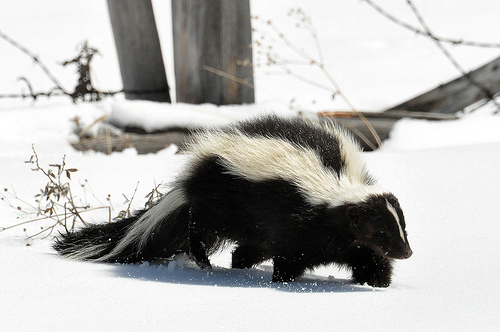Aaaah! The skunk stinks!
- Skunks are a family of nocturnal mammals native to the Americas, that typically have striped or spotted fur, in colours of black or brown and white or cream.
- Skunks have the scientific family name Mephitidae, meaning ‘stench’, which is the family of skunks and stink badgers, that consists of 12 or 13 species, and the more well known striped Mephitis mephitis species is sometimes domesticated.
- ‘Skunks’ are also known as ‘polecats’ in the United States of America, and while they were originally in the same family as typical polecats, in the Mustelidae family, they are only distantly related.
- Depending on the species, skunks measure 40 to 94 centimetres (1.3 to 3 feet) in length, and weigh 0.2 to 8.2 kilograms (0.4 to 18 pounds).
- Skunks eat a variety of food items including fruit, nuts, plant material, honeybees, larvae, worms, small mammals, small reptiles and eggs, and others.
Striped Skunk
Image courtesy of Dan Dzurisin/Flickr
- Skunks have glands on their rear under their tail, that produce a very stinky spray that contains sulphur, that is able to reach enemies up to 3 metres (10 feet) away and can be smelt up to a kilometre (0.6 miles) away.
- Skunks have good hearing and smelling capabilities, but can only see up to 3 metres (10 feet) away.
- Skunks live in burrows where they stay during winter and cooler weather for lengthy periods, but they do not genuinely hibernate.
- Female skunks give birth to two to ten babies a year, known as kits, that are born deaf and blind, and they have an average three year lifespan, although it ranges from one to seven years in the wild, and up to ten years in captivity.
- Skunks are preyed upon by great horned owls and some other species of birds, as well as some land dwelling animals, particularly from the dog family, Canidae, even though most are deterred by the stripey colouring and the strongly scented spray of the animal.
Bibliography:
Skunk, 2014, National Geographic, http://animals.nationalgeographic.com.au/animals/mammals/skunk/
Skunk, 2014, Wikipedia, http://en.wikipedia.org/wiki/Skunk






